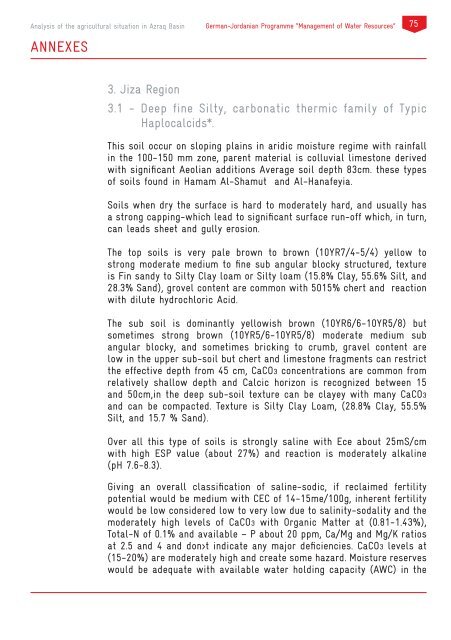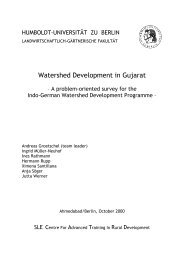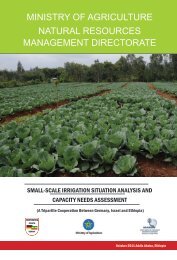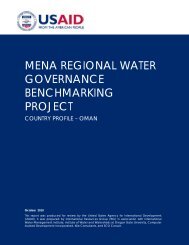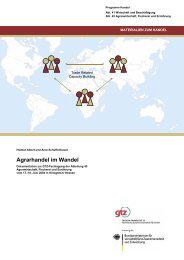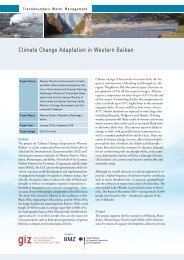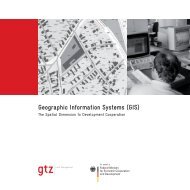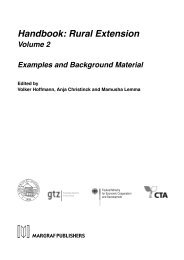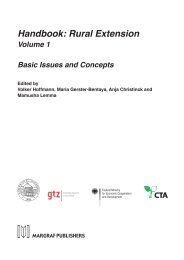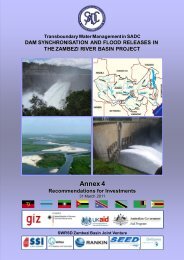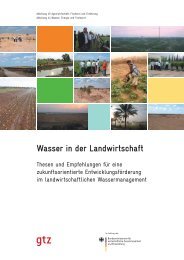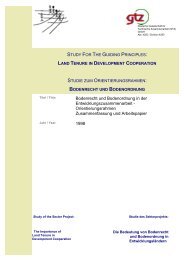Farming in the - WordPress.com
Farming in the - WordPress.com
Farming in the - WordPress.com
Create successful ePaper yourself
Turn your PDF publications into a flip-book with our unique Google optimized e-Paper software.
Analysis of <strong>the</strong> agricultural situation <strong>in</strong> Azraq Bas<strong>in</strong><br />
ANNEXES<br />
German-Jordanian Programme “Management of Water Resources”<br />
75<br />
3. Jiza Region<br />
3.1 - Deep f<strong>in</strong>e Silty, carbonatic <strong>the</strong>rmic family of Typic<br />
Haplocalcids*.<br />
This soil occur on slop<strong>in</strong>g pla<strong>in</strong>s <strong>in</strong> aridic moisture regime with ra<strong>in</strong>fall<br />
<strong>in</strong> <strong>the</strong> 100-150 mm zone, parent material is colluvial limestone derived<br />
with significant Aeolian additions Average soil depth 83cm. <strong>the</strong>se types<br />
of soils found <strong>in</strong> Hamam Al-Shamut and Al-Hanafeyia.<br />
Soils when dry <strong>the</strong> surface is hard to moderately hard, and usually has<br />
a strong capp<strong>in</strong>g-which lead to significant surface run-off which, <strong>in</strong> turn,<br />
can leads sheet and gully erosion.<br />
The top soils is very pale brown to brown (10YR7/4-5/4) yellow to<br />
strong moderate medium to f<strong>in</strong>e sub angular blocky structured, texture<br />
is F<strong>in</strong> sandy to Silty Clay loam or Silty loam (15.8% Clay, 55.6% Silt, and<br />
28.3% Sand), grovel content are <strong>com</strong>mon with 5015% chert and reaction<br />
with dilute hydrochloric Acid.<br />
The sub soil is dom<strong>in</strong>antly yellowish brown (10YR6/6-10YR5/8) but<br />
sometimes strong brown (10YR5/6-10YR5/8) moderate medium sub<br />
angular blocky, and sometimes brick<strong>in</strong>g to crumb, gravel content are<br />
low <strong>in</strong> <strong>the</strong> upper sub-soil but chert and limestone fragments can restrict<br />
<strong>the</strong> effective depth from 45 cm, CaCO3 concentrations are <strong>com</strong>mon from<br />
relatively shallow depth and Calcic horizon is recognized between 15<br />
and 50cm,<strong>in</strong> <strong>the</strong> deep sub-soil texture can be clayey with many CaCO3<br />
and can be <strong>com</strong>pacted. Texture is Silty Clay Loam, (28.8% Clay, 55.5%<br />
Silt, and 15.7 % Sand).<br />
Over all this type of soils is strongly sal<strong>in</strong>e with Ece about 25mS/cm<br />
with high ESP value (about 27%) and reaction is moderately alkal<strong>in</strong>e<br />
(pH 7.6-8.3).<br />
Giv<strong>in</strong>g an overall classification of sal<strong>in</strong>e-sodic, if reclaimed fertility<br />
potential would be medium with CEC of 14-15me/100g, <strong>in</strong>herent fertility<br />
would be low considered low to very low due to sal<strong>in</strong>ity-sodality and <strong>the</strong><br />
moderately high levels of CaCO3 with Organic Matter at (0.81-1.43%),<br />
Total-N of 0.1% and available – P about 20 ppm, Ca/Mg and Mg/K ratios<br />
at 2.5 and 4 and don>t <strong>in</strong>dicate any major deficiencies. CaCO3 levels at<br />
(15-20%) are moderately high and create some hazard. Moisture reserves<br />
would be adequate with available water hold<strong>in</strong>g capacity (AWC) <strong>in</strong> <strong>the</strong>


